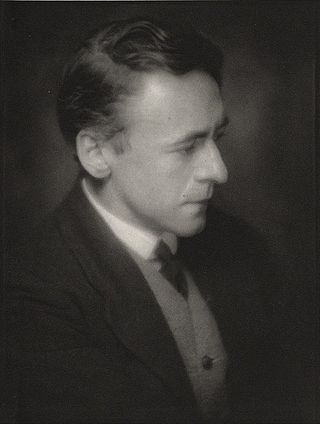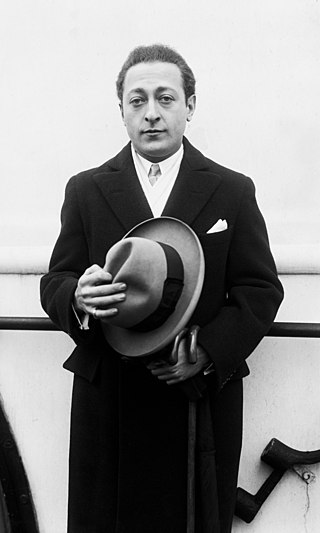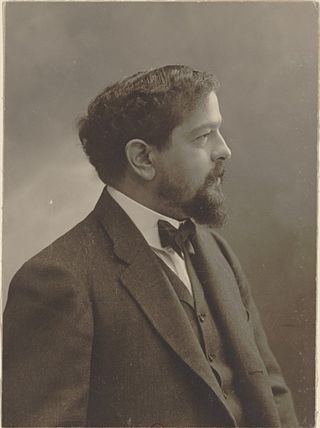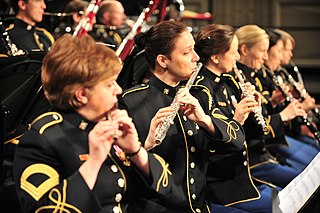Structure
November Woods, like several other symphonic poems by Bax, is inspired by nature. The composer disavowed any programmatic content, declaring that the work "may be taken as an impression of the dank and stormy music of nature in the late autumn, but the whole piece and its origins are connected with certain rather troublous experiences I was going through myself at the time....". [3] The experiences to which he alluded were connected with the break-up of his marriage and his love affair with the pianist Harriet Cohen. [4] The untroubled second theme of the work may, according to the commentator Keith Anderson, suggest more tranquil feelings of earlier days. [5]
In the earlier years of his career, Bax was given to writing for very large orchestral forces. [6] November Woods calls for three flutes; piccolo; two oboes; cor anglais; three clarinets, one bass clarinet; two bassoons, one contrabassoon; four horns; three trumpets; three trombones; one tuba; two harps; timpani; cymbals; bass drum; glockenspiel; celeste; and strings. [4] The analyst John Palmer comments that despite the large forces, Bax's orchestration is among the most subtle in his entire oeuvre: "In the opening moments, quivering woodwinds, harps, and muted strings present a delicately shifting array of colors". [4] Palmer draws attention to instrumental combinations, such as oboe doubling cello and viola playing with bassoon and cor anglais. [4]
After an opening that evokes a strong breeze, with harp glissandi and a swift and agile woodwind theme, a muted solo cello moves the melodic content forward. The main theme, a descending, chromatic, three-note figure, dominates the first part of the work, which is developed before the second subject, an andante con moto, in which harp and celeste add colour to a theme played by cor anglais, bassoon and viola. A central section, with pianissimo strings and high horns precedes a brief sonata form development and recapitulation. After a sonorous climax the music returns to the opening key of G minor and the work ends with the bass clarinet fading to a quiet finish. [4] [5]
The work plays for about 16–17 minutes. [5]

Orchestration is the study or practice of writing music for an orchestra or of adapting music composed for another medium for an orchestra. Also called "instrumentation", orchestration is the assignment of different instruments to play the different parts of a musical work. For example, a work for solo piano could be adapted and orchestrated so that an orchestra could perform the piece, or a concert band piece could be orchestrated for a symphony orchestra.
The Pomp and Circumstance Marches, Op. 39, are a series of five marches for orchestra composed by Sir Edward Elgar. The first four were published between 1901 and 1907, when Elgar was in his forties; the fifth was published in 1930, a few years before his death; and a sixth, compiled posthumously from sketches, was published in 1956 and in 2005–2006. They include some of Elgar's best-known compositions.

Sir Arnold Edward Trevor Bax was an English composer, poet, and author. His prolific output includes songs, choral music, chamber pieces, and solo piano works, but he is best known for his orchestral music. In addition to a series of symphonic poems, he wrote seven symphonies and was for a time widely regarded as the leading British symphonist.

The Swan of Tuonela is an 1895 tone poem by the Finnish composer Jean Sibelius. It is part of the Lemminkäinen Suite, Op. 22, based on the Finnish mythological epic the Kalevala.

The Violin Concerto by William Walton was written in 1938–39 and dedicated to Jascha Heifetz, who commissioned the work and performed it at its premiere on 7 December 1939 with the Cleveland Orchestra conducted by Artur Rodziński. The British premiere, delayed by the Second World War, was given on 1 November 1941, with Henry Holst as soloist and the composer conducting. Walton later reorchestrated the concerto; the revised version was premiered in 1944. The work has been frequently recorded and has established itself as one of the composer's most durable compositions.
A London Symphony is the second symphony that Ralph Vaughan Williams composed. The work is sometimes referred to as Symphony No. 2, though the composer did not designate that name for the work. First performed in 1914, the original score of this four-movement symphony was lost and subsequently reconstructed. Vaughan Williams continued revisions of the work into its final definitive form, which was published in 1936.

Prélude à l'après-midi d'un faune, known in English as Prelude to the Afternoon of a Faun, is a symphonic poem for orchestra by Claude Debussy, approximately 10 minutes in duration. It was composed in 1894 and first performed in Paris on 22 December 1894, conducted by Gustave Doret. The flute solo was played by Georges Barrère.
The Viola Concerto by William Walton was written in 1929 and first performed at the Queen's Hall, London on 3 October of that year by Paul Hindemith as soloist and the composer conducting. It had been written with the violist Lionel Tertis in mind, and he took the work up after initially rejecting it. The concerto established Walton as a substantial figure in British music and has been recorded by leading violists internationally. Walton revised the instrumentation of the concerto in 1961, lightening the orchestral textures.
Roman Festivals, P 157 is a tone poem in four movements for orchestra completed in 1928 by the Italian composer Ottorino Respighi. It is the last of his three tone poems about Rome, following Fountains of Rome (1916) and Pines of Rome (1924), which he referred to as a triptych. Each movement depicts a scene of celebration in ancient and contemporary Rome, specifically gladiators battling to the death, the Christian Jubilee, a harvest and hunt festival, and a festival in the Piazza Navona. Musically, the piece is the longest and most demanding of Respighi's Roman trilogy.

Ein Heldenleben, Op. 40, is a tone poem by Richard Strauss. The work was completed in 1898. It was his eighth work in the genre, and exceeded any of its predecessors in its orchestral demands. Generally agreed to be autobiographical in nature despite contradictory statements on the matter by the composer, the work contains more than thirty quotations from Strauss's earlier works, including Also sprach Zarathustra, Till Eulenspiegel, Don Quixote, Don Juan, and Death and Transfiguration.
Nocturne, Op. 60, is a song cycle by Benjamin Britten, written for tenor, seven obbligato instruments and strings. The seven instruments are flute, cor anglais, clarinet, bassoon, harp, French horn and timpani.
The Overture to a Picaresque Comedy is a concert overture composed by Arnold Bax in 1930. It was premiered by the Hallé Orchestra conducted by the dedicatee, Sir Hamilton Harty, in November 1931. The work is untypical of its composer, who was not usually associated with comedy in music.
The Symphony No. 2 in E minor and C major by Arnold Bax was completed in 1926, after he had worked on it for two years. It was dedicated to Serge Koussevitzky, who conducted the first two performances of the work on 13 and 14 December 1929.
The Symphony No. 6 by Arnold Bax was completed on February 10, 1935. The symphony is dedicated to Sir Adrian Boult. It is, according to David Parlett, "[Bax's] own favourite and widely regarded as his greatest ... powerful and tightly controlled". It was given its world premiere by the Royal Philharmonic on November 21 of the year of composition, 1935.
The Symphony No. 3 by Arnold Bax was completed in 1929. It was dedicated to Sir Henry Wood and is perhaps the most performed and most immediately approachable of Bax's symphonies.

The woodwind section, which consists of woodwind instruments, is one of the main sections of an orchestra or concert band. Woodwind sections contain instruments given Hornbostel-Sachs classifications of 421 and 422, but exclude 423
The Garden of Fand (1916) is a tone poem by the English composer Arnold Bax. It was inspired by an Irish mythical figure, Fand, the daughter of the lord of the ocean. The work does not portray the events of the mythical tale, but evokes Fand's island. The composer had been greatly influenced by Celtic culture in his earlier works, but described this one as his last in that vein.
In the Faëry Hills, to which the composer gave the alternative Irish title An Suagh Sidhe, is a symphonic poem by Arnold Bax. It was composed in 1909 and was premiered in London in 1910. It is the second of three works that make up a trilogy of symphonic poems with the collective title Eire. The inspiration for the piece was The Wanderings of Oisin by the poet W. B. Yeats, whom Bax greatly admired.
The Happy Forest is a symphonic poem by Arnold Bax. It was composed as a piano piece in 1914, and orchestrated in 1922. The inspiration for the work was a story of the same name by Herbert Farjeon, a rural idyll with mythical figures delighting the observer. Bax's treatment is an evocation of the mood of the story rather than a programmatic depiction of the incidents.
Campane di Ravello (A Celebration Piece for Sir Georg Solti) is a short orchestral composition by the American composer John Corigliano. The work was commissioned by the Chicago Symphony Orchestra for the 75th birthday of its then music director Georg Solti. Its world premiere was given by the Chicago Symphony Orchestra under the direction of Kenneth Jean on October 9, 1987.






